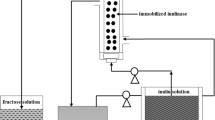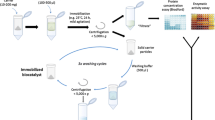Abstract
A trickle-bed system employing inert matrices of vermiculite or polyurethane foam packed in the downcomer section of a split-flow air-lift reactor has been developed for hybridoma culture to enhance antibody productivity. This quiescent condition favoured occlusion and allowed the cells to achieve densities twelve fold greater (12.8×106 cells/ml reactor for polyurethane foam) than in free cell suspension.
The reactor was operated in a cyclic batch mode whereby defined volumes of medium were periodically withdrawn and replaced with equal volumes of fresh medium. The pH of the medium was used as the indicator of the feeding schedule. Glucose, lactate and ammonia concentrations reached a stationary value after 5 days. With vermiculite packing, a monoclonal antibody (MAb) concentration of 2.4 mg/l was achieved after 12 days. The MAb concentration declined then increased to a value of 1.8 mg/l. In the polyurethane foam average monoclonal antibody (MAb) concentrations reached a stationary value of 1.1 mg/l in the first 20 days and increased to a new stationary state value of 2.1 mg/l for the remainder of the production. MAb productivity in the trickle-bed reactor was 0.3 mg/l·d (polyurethane foam) and 0.18 mg/l.d (vermiculite) in comparison to 0.12 mg/l·d for free cell suspension. This trickle-bed system seems to be an attractive way of increasing MAb productivity in culture.
Similar content being viewed by others
References
Bosworth JM, Brimfield AA, Naylor JA and Hunter KW Jr (1983) Measurement of monoclonal antibody concentrations in hybridoma cultures: Comparison of competitive inhibition and antigen capture enzyme immunoassays. J Immunol Meth 62: 331–336.
Buehler RJ (1984) Production of monoclonal antibody from gel entrapped hybridoma cells. Karyon Technol News 1 (1): 3.
Dean RC Jr, Karkare SB, Phillips PG, Ray NG and Runstadler PW (1986) Continuous cell culture with fluidized sponge beads for large scale production of medical proteins. Verax Corporation Report, New Hampshire, USA.
Handa-Corrigan A, Emery AN and Spier RE (1987) On the evaluation of gas liquid interfacial effects on hybridoma viability in bubble column reactors. Dev Biol Stand 66: 241–253.
Handa-Corrigan A, Emery AN and Spier RE (1989) Effect of gas-liquid interfaces on the growth of suspended mammalian cells: mechanisms of cell damage by bubbles. Enzyme Microb Technol 11: 230–235.
Hayward GL, Scharer JM, Moo-Young M and Bols NC (1991) Photometric ELISA calibration for antibody assay. Biotech Tech 5: 35–38.
Iijima S, Mano T, Taniguchi M and Kobayashi T (1988) Immobilization of hybridoma cells with alginate and urethane polymer and improved monoclonal antibody production. Appl Microbiol Biotechnol 28: 572–576.
Karkare SB, Phillips PG, Burke DH and Dean RC (1985) Continuous production of monoclonal antibodies by chemostatic and immobilized hybridoma culture. In: Feder J and Tolbert WR (eds) Large Scale Mammalian Cell Culture, Academic Press, New York.
Lazar A (1988) Immobilized animal cell culture systems for production of biologicals. Presented at ACS Conference, Boston, USA.
Lindsey K and Yeoman MM (1987) Techniques for the immobilization of plant cells. Meth Enzymol 135: 410–421.
Mavituna F, Wilkinson AK, Williams PD and Park JM (1987) Production of secondary metabolites by immobilized plant cells in novel bioreactors. Presented at the International Conference on Bioreactors and Biotransformations, Scotland.
Murdin AD, Thorpe JS, Kirby N, Groves DE and Spier RE (1987) Immobilization and growth of hybridomas in packed beds. Presented at the International Conference on Bioreactors and Biotransformations, Scotland.
Murdin AD, Thorpe JS, Groves DE and Spier RE (1989) Growth and metabolism of hybridomas immobilized in packed beds: Comparison with static and suspension cultures. Enzyme Microb Technol 11: 341–346.
Nilsson K, Scheirer W, Merten O-W, Lostberg E, Katinger HW and Mosbach K (1983) Entrapment of animal cells for production of monoclonal antibodies and other biomolecules. Nature 302: 629–630.
Nilsson K, Buzsaky F and Mosbach K (1986a) Growth of anchorage dependent cells on macroporous microcarriers. Biotechnology 4: 989–990.
Nilsson K, Scheirer W, Katinger HWD, Mosbach K (1986b) Production of monoclonal antibodies by agarose-entrapped hybridoma cells. In: Mosbach K (ed) Academic Press, London, Meth Enzymol 121: 352–360.
Nilsson K (1987) Mammalian cell culture. In: Mosbach K (ed) Academic Press, London, Meth Enzymol 135: 183–193.
Overgaard S, Scharer JM, Bols NC and Moo-Young M (1991) Immobilization of hybridoma cells in chitosan stabilized calcium alginate beads. Can J Chem Eng 69: 439–443.
Phillips HA (1991) Evaluation of hybridoma culture systems. PhD Thesis. University of Waterloo, Waterloo, Ontario, Canada.
Phillips J (1973) Dye-exclusion tests for viability. In: Kruse PF Jr and Patterson MR Jr (ed) Tissue Culture Methods of Applications. Academic Press, New York.
Author information
Authors and Affiliations
Rights and permissions
About this article
Cite this article
Phillips, H.A., Scharer, J.M., Bols, N.C. et al. Design and performance of a trickle-bed bioreactor with immobilized hybridoma cells. Cytotechnology 9, 29–40 (1992). https://doi.org/10.1007/BF02521729
Received:
Accepted:
Issue Date:
DOI: https://doi.org/10.1007/BF02521729




